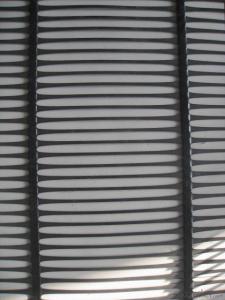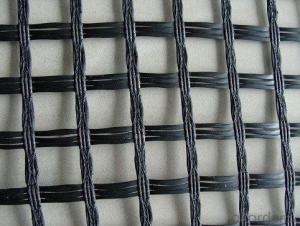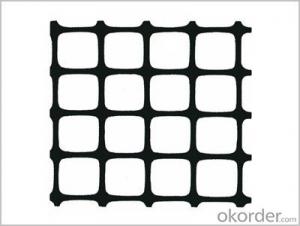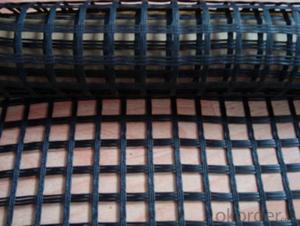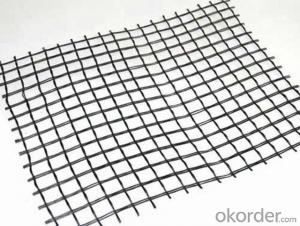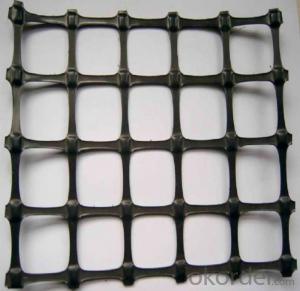Biaxial Geogrid of Civil Engineering Products Used in Dams
- Loading Port:
- China main port
- Payment Terms:
- TT OR LC
- Min Order Qty:
- 1000 m²
- Supply Capability:
- 10000000 m²/month
OKorder Service Pledge
OKorder Financial Service
You Might Also Like
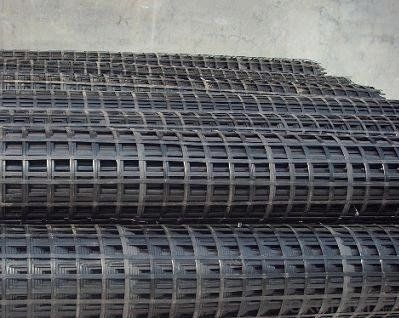
Product Introduction
The geogrid elements vary in polymer type and cross-sectional dimensions. They can sometimes change shape and dimensions within their length. Geogrids are either integrally manufactured (punched and drawn sheets; or extruded), ultrasonically or adhesive bonded strips, or joined in a knitting or weaving process and then coated. Polymer types include polyethylene, polypropylene or high tenacity polyester that has been coated.
Extruded Geogrids are flat structures in polymer (usually high density polyethylene or polypropylene) that are extruded and then pulled: this may be done in one direction (mono-oriented geogrids), or in the two main directions (bi-oriented geogrids). They are used in soil and road paving reinforcement. Slopes and subgrades with rails are a serious problem in railroad construction. Under high pressure the layers slide and deform consequently causing rail deformation, which requires closing railroad segments for a long time. Geogrid application allows carrying out comlex repair operations of the necessary road segment in shortest time (which is very essential in transportation).
Our Service
Quality assurance
1.On a regular basis or as per your request,we entrust national testing agencies to conduct quality inspections
2. Strictly in accordance with the ISO9001-2008 international quality system standard,we monitor and manage the whole process throughout production,quality testing,and measurement to ensure product quality
3. For quality-related construction delay or substandard construction(except for damage or losses due to customer’s responsibility or irresistible natural disasters),we have refunding,replacement,and repair services.We will respond to customers’ feedbacks on quality issues within 24 hours.
Packaging & Shipping
Packing: PLASTIC FILM INSIDE, AND WOVEN BAG OUTSIDE
Shipping: About 15 days after receipt the deposit
FAQ:
Q: What kind of payments does jenor support?
A: T/T, L/C, Cash are accepted.
Q: Do you charge for the samples?
A: Accordeing to our company policy, the samples are free, we only charge the freight fee. And we will return the freight fee during the next order.
Q: Can you produce according to customers' design?
A: Sure, we are professional manufacturer, OEM and ODM are both welcome.
Q: Do you have other products?
A: Yes, please check the pictures:
- Q:What is the difference between a uniaxial and a biaxial geogrid?
- A uniaxial geogrid is designed to provide strength and stabilization in one primary direction, typically in the longitudinal direction. On the other hand, a biaxial geogrid is capable of providing strength and stabilization in two perpendicular directions, both in the longitudinal and transverse directions.
- Q:What materials are used to make geogrids?
- Geogrids are typically made from various materials such as polypropylene, polyester, or fiberglass.
- Q:Unidirectional tensile plastic geogrid manufacturers which good
- (1) the plastic geogrid plastic geogrid is a kind of polymer material with square or rectangular shape which is formed by stretching, and it can be used as one kind of unidirectional stretching and biaxial stretching according to the different direction of stretching in the manufacturing process. The utility model is punched on the extruded polymer plate (raw material is polypropylene or high-density polyethylene), and then directionally stretched under the heating condition
- Q:Are geogrids resistant to acid degradation?
- Yes, geogrids are generally resistant to acid degradation. They are commonly made from materials such as polypropylene or polyester which have excellent resistance to acidic environments. This resistance allows geogrids to maintain their structural integrity and performance even when exposed to acidic conditions.
- Q:Can geogrids be used in construction of temporary access roads over soft ground?
- Yes, geogrids can be used in the construction of temporary access roads over soft ground. Geogrids are commonly used in civil engineering projects to reinforce and stabilize weak soil. By distributing load and providing tensile strength, geogrids can enhance the stability of temporary access roads, preventing sinking or rutting caused by soft ground conditions.
- Q:Can geogrids be used in reinforcement of bridge abutments on soft clays?
- Yes, geogrids can be used in the reinforcement of bridge abutments on soft clays. Geogrids are commonly used in geotechnical engineering to improve the stability and strength of soil structures. In the case of bridge abutments on soft clays, geogrids can provide lateral reinforcement and enhance the load-bearing capacity of the soil, reducing settlement and improving overall stability.
- Q:How do geogrids improve the performance of reinforced soil walls?
- Geogrids improve the performance of reinforced soil walls by providing additional strength and stability to the soil structure. They act as a reinforcement material, distributing the forces exerted on the wall more evenly and preventing the soil from sliding or collapsing. This results in increased load-bearing capacity, reduced settlement, and improved overall stability of the reinforced soil walls.
- Q:Can geogrids be used in shoreline protection projects?
- Yes, geogrids can be used in shoreline protection projects. Geogrids are often used to reinforce soil and prevent erosion in various applications, including shoreline protection. By providing additional strength and stability to the soil, geogrids can help to prevent the erosion of the shoreline and protect it from the damaging effects of waves and currents.
- Q:How do geogrids improve the performance of geosynthetic-reinforced walls?
- Geogrids improve the performance of geosynthetic-reinforced walls by providing additional tensile strength and stability to the structure. They act as a reinforcement material, distributing the load and preventing soil movement or wall failure. Geogrids also enhance the overall durability and longevity of the wall by reducing the potential for settlement, soil erosion, and deformation.
- Q:Can geogrids be used in reinforcement of geosynthetic clay liners?
- Yes, geogrids can be used in the reinforcement of geosynthetic clay liners. Geogrids are commonly used as a secondary reinforcement layer in geosynthetic clay liners to enhance their tensile strength and improve their overall performance in various engineering applications.
1. Manufacturer Overview |
|
|---|---|
| Location | |
| Year Established | |
| Annual Output Value | |
| Main Markets | |
| Company Certifications | |
2. Manufacturer Certificates |
|
|---|---|
| a) Certification Name | |
| Range | |
| Reference | |
| Validity Period | |
3. Manufacturer Capability |
|
|---|---|
| a)Trade Capacity | |
| Nearest Port | |
| Export Percentage | |
| No.of Employees in Trade Department | |
| Language Spoken: | |
| b)Factory Information | |
| Factory Size: | |
| No. of Production Lines | |
| Contract Manufacturing | |
| Product Price Range | |
Send your message to us
Biaxial Geogrid of Civil Engineering Products Used in Dams
- Loading Port:
- China main port
- Payment Terms:
- TT OR LC
- Min Order Qty:
- 1000 m²
- Supply Capability:
- 10000000 m²/month
OKorder Service Pledge
OKorder Financial Service
Similar products
New products
Hot products
Hot Searches
Related keywords
